AMD Socket-AM2: Same Performance, Faster Memory, Lower Power
by Anand Lal Shimpi on May 23, 2006 12:14 PM EST- Posted in
- CPUs
A New FX
The next new CPU introduction that we're here to evaluate is the Athlon 64 FX-62, a 2.8GHz dual-core FX part that's debuting exclusively on the Socket-AM2 platform. Given AMD's policy of only having one active FX part at a time (prior violations of this rule aside), the FX-62 is the only FX on the AM2 platform. The FX-60 still reigns supreme on the Socket-939 platform, and since the two platforms perform the same we can pretty much compare the FX-60 to the FX-62 directly without worrying about any motherboard/memory/chipset differences skewing the comparison. Of course no very-high-end CPU comparison is complete without Intel's latest Extreme Edition processor, which in this case is the Pentium Extreme Edition 965 we reviewed back in March.
3D Rendering - Cinebench 9.5
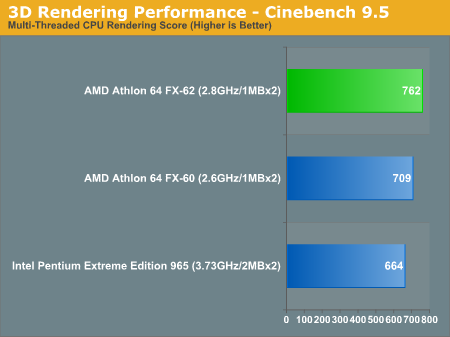
The beauty of the FX series of AMD processors is that its cache size doesn't vary like the rest of the Athlon 64 line, so the FX-62 has an undeniable performance advantage thanks to its 2.8GHz clock speed. The clock speed advantage is able to give it a pretty decent performance boost over the FX-60 here, as well as over the Pentium EE 965.
3D Rendering - 3dsmax 7
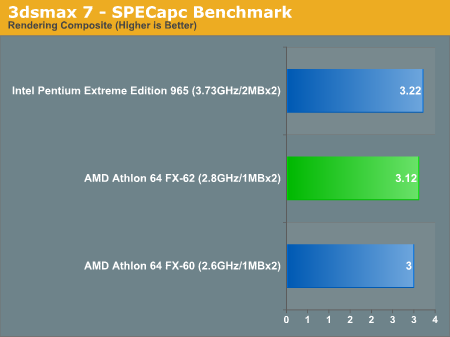
While we see a performance increase over the FX-60 in 3dsmax 7, it isn't enough to catch up to the performance of the Pentium EE 965. At 3.73GHz, the 965 is an extremely formidable competitor and very high performance CPU for 3dsmax rendering tasks.
Video Encoding - DivX 6.1.1 Pro
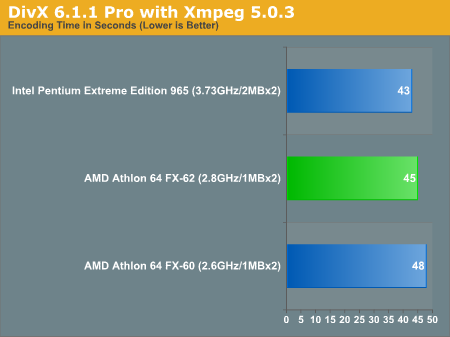
Intel gets the slight nod in DivX encoding performance, with the FX-62 falling smack in the middle of the chart here between the 965 and the FX-60.
Video Encoding - Windows Media Encoder 9
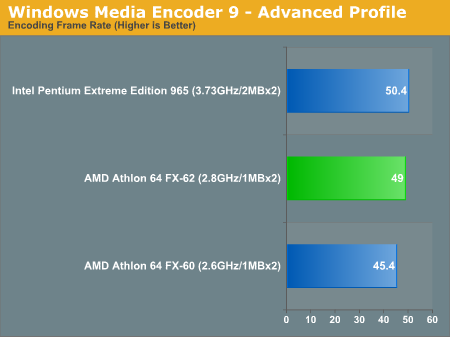
The situation doesn't really change with WME9; the FX-62 manages to come very close to the Extreme Edition 965's performance but falls a little short. The improvement over the FX-60 is quite noticeable here.
Video Encoding - Quicktime 7.0.4 (H.264)
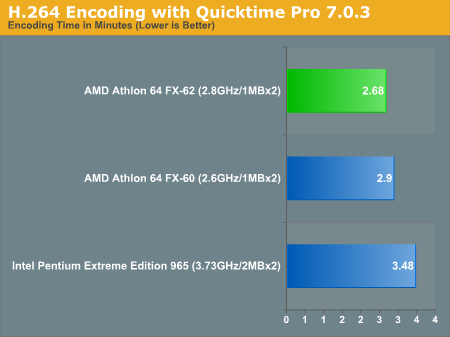
Apple's Quicktime for Windows has never run well on Intel processors, and the FX-62 takes good advantage of that fact by putting the Extreme Edition 965 to shame in our H.264 encoding test. After looking at the 4000+ vs. 3800+ comparison on the previous page, it's nice to see a real tangible performance difference between two AMD CPUs.
MP3 Encoding - iTunes 6.0.1.4
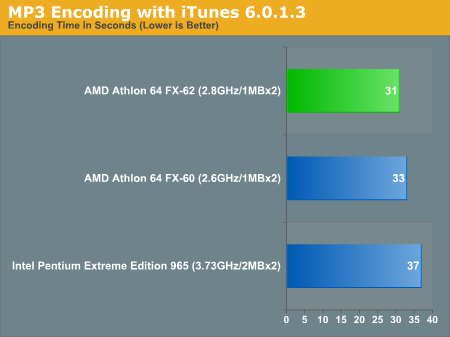
While all three CPUs are very competitive in their MP3 encoding performance the Athlon 64 FX-62 is the clear winner here, finishing the encoding task 16% faster than the Pentium EE 965.
Gaming - Quake 4
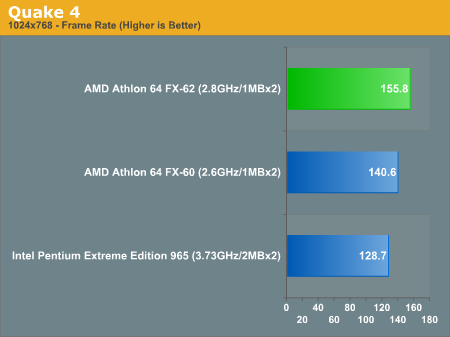
At higher clock speeds the Athlon 64 FX-62 really separates itself from the Pentium EE 965, offering a very significant 21% performance advantage in Quake 4.
Gaming - F.E.A.R.
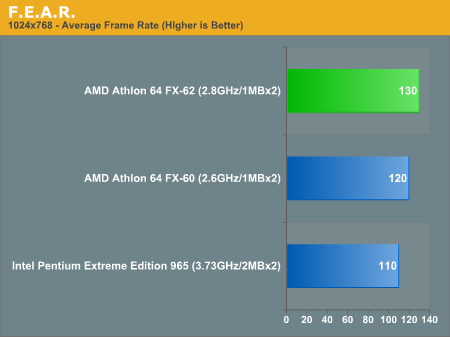
The AMD gaming advantage continues in F.E.A.R., this time the FX-62 holds on to a solid 18% lead.
Gaming - Oblivion
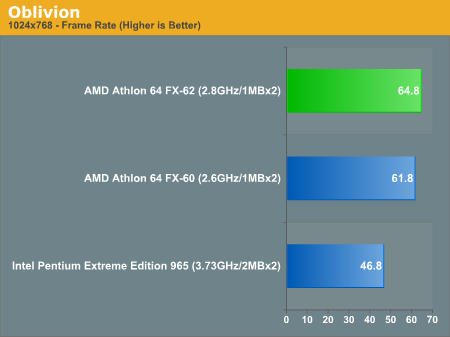
The Pentium Extreme Edition 965 is utterly disappointing in Oblivion, as the FX-62 outperforms it by an incredible 38%. With a very CPU and GPU dependent game like Oblivion, you can't ignore these types of performance differences, especially if you plan on feeding a pair of high end GPUs in SLI or CrossFire.
Athlon 64 FX-62 Conclusion
The Athlon 64 FX-62 verdict is a lot easier than with the 4000+ since the performance advantage is clear thanks to a 1MB L2 cache per core and an increase in clock speed. We would still recommend the FX-62 over the Extreme Edition 965 for gamers, but as we've seen in the past there are some situations where being able to execute four simultaneous threads, as you can with the EE, has its benefits.
Given the incredible price premium you pay for the FX-62, we would still strongly recommend going with a lower clocked Athlon 64 X2 instead. You can always overclock to get close to FX-62 performance or, alternatively, you could stay at the lower clock speed and enjoy lower thermal output.










83 Comments
View All Comments
peternelson - Tuesday, May 23, 2006 - link
I see no benchmarking in 64 bit mode.
This is the future, and for maths, Intel's 64 bit was more of a lame copy of AMD 64 bit performance.
In future this will be increasingly important so even if 32 bit performances are comparable, I'd want to make sure the picture is the same running 64 bit apps.
Also you summarise "same performance, faster memory, less power". True, but you FORGET one of the main benefits: Pacifica Virtualisation.
True hardware virtualisation adds to the actual WORK you can keep that processor busy with. It saves time by letting you switch OS instances without rebooting timewasting.
As it is hardware based VT you should even be able to virtualise an UNMODIFIED OS like Win XP, maybe even Vista!
So please play with Xen3.
As you say virtualisation "works" then it is a BIG factor for me in choosing AM2 over 939, (all other things being equal).
Also the fastest 939 chips have been produced, and AM2 is reaching higher models now.
So if you want the VERY fastest, it is only available on AM2.
Don't forget: Not just performance, but performance PER WATT. For these AM2 chips that is similar to 939.
However, the announcement of 65W EE and EVEN 35W SFF EE!!! are significant compared to the standard 89W
Intel seem to be positioning Conroe as being "33% better" on performance per watt. However, Conroe isn't even here but when it is, it may not be able to compete with AMD low power offerings.
Also consider the whole system for conroe vs AMD. Because that AMD power INCLUDES the memory controller, whereas Intel doesn't. The whole motherboard etc may use less power.
Also in terms of entire system cost, motherboards for AM2 appear to be a bit cheaper than their Intel equivalents, which may offset the current high prices of AMD processors.
fitten - Wednesday, May 24, 2006 - link
You should check out the Woodcrest (server targeted Conroe core) previews for power measurements. Performance per Watt, Woodcrest wins (and will be available in 3 weeks)... Absolute power usage under load, Woodcrest wins... and note that the power measurements are for the complete system (video card and HDDs included). (Deep power conservation couldn't be tested on Woodcrest because the parts didn't have it enabled as they were engineering samples.)Also, check out the 64bit vs. 32bit comparisons in programs like Cinebench 9.5. Seems Woodcrest 64bit gives a nice boost there (showing that it isn't just a 'lame copy').
You also seem to forget that Intel already has virtualization extensions out in currently shipping processors (much less Conroe+).
As far as price, there have been price lists published already. High end Conroe parts are already listed for 1/2 the price of the high end AMD parts... at $500 that gives another $500 for purchase of a motherboard before it touches just the CPU cost of the AMD... I doubt that the motherboards will be that expensive.
I have 7 AMD machines (four are Athlon64s or X2s) but right now, it looks like my next machine will be a Core2 one. AMD needs to get an answer out... soon. K8L isn't going to cut it. Sure, it'll be good at FPU but the vast majority of work done by CPUs is integer, which are what the majority of improvements are in Core2 (not that they don't have good FPU improvements). So, if you're in a government lab running FPU intensive simulations, K8L may be for you. If you're anyone else, K8L as it has been described looks kind of anemic and not a match for Core2.
Maybe the real K8L will surprise us, who knows, but it is at least 6 months away (if not longer). By that time, Intel will already be 25% into it's 2-year cycle for the next Core derivative chip (probably farther, time between releases is set to 2-years). AMD looks to be in a bad situation right now... If they have something they're keeping secret, IMO, they need to at least tease us with it. K8L is not a tease, it's only slightly more than a stifled yawn. The longer they go without giving us something to look forward to, the more it looks like they are in major trouble.
Accord99 - Wednesday, May 24, 2006 - link
[quote]Don't forget: Not just performance, but performance PER WATT. For these AM2 chips that is similar to 939.However, the announcement of 65W EE and EVEN 35W SFF EE!!! are significant compared to the standard 89W
Intel seem to be positioning Conroe as being "33% better" on performance per watt. However, Conroe isn't even here but when it is, it may not be able to compete with AMD low power offerings. [/quote]
Given that Woodcrest 3.0GHz has a TDP of 65W, which is borne out by power measurements conducted by Techreport and 2CPU, it's likely that a Conroe that matches the performance of the 35W X2 will at the very least, also match it in power.
soydios - Tuesday, May 23, 2006 - link
AMD motherboards are less expensive because they don't have to put in a memory controller.AMD processors are more expensive for 2 reasons:
- integrated memory controller takes up more die space (offset by cheaper motherboard)
- AMD is still using 90nm on 200mm wafers, while Intel is using 65nm on 300mm wafers (Intel gets more CPUs per wafer bigtime)
peternelson - Tuesday, May 23, 2006 - link
Sempron AM2 can do memory up to DDR2-667
Dualcore AM2 can do memory up to DDR2-800
However, PLEASE CHECK SINGLE CORE MEMORY SPEED (multiplier issues aside) which you say limited to 667 whereas I got the impression they can also do 800 like dualcores. Correct as necessary.
smitty3268 - Tuesday, May 23, 2006 - link
I accidentally hit the "not worth reading" button, so I'm writing this comment to undo it :)fikimiki - Tuesday, May 23, 2006 - link
There are a couple of reasons for that:- K8L photo had a Z-RAM implemented, so they are using this kind of cache for a quite long time.
- Shared L3 should help Athlon64 in matching Super-Pi and overall performance.
- Usage of Z-RAM will reduce cache die size by 75% with no architectural changes.
So FX-64 to beat fastest Core 2 just needs 4MB of cache...
Easy trick but can be useful to survive till 65nm production...
Questar - Tuesday, May 23, 2006 - link
It's not going to be Z-RAM. Z-RAM won't even be in K8L.
“We’ve looked at data from Innovative Silicon and it looks very promising. We still need to assure ourselves that this will work in our own application. We need to see how it scales and we need to make our own test vehicles,”
Jones, an executive experienced in intellectual property licensing, also declined to comment on AMD’s timetable for introduction of Z-RAM but offered a more general perspective. “In the past it has been two years from when you sign a deal to when it is in production.”
http://www.eetimes.com/news/latest/showArticle.jht...">http://www.eetimes.com/news/latest/showArticle.jht...
munky - Tuesday, May 23, 2006 - link
I think the June trick AMD will pull out is the Clearspeed coprocessor. It definitely won't affect many users, but for those who do invest in the technology, it could provide a decent boost in number crunching power.peternelson - Tuesday, May 23, 2006 - link
Clearspeed are working on being one acceleration solution, yes, but the already launched acceleration on socket 940 is companies offering plug in Xilinx4 FPGA on hypertransport.
I hope that gets re-engineered onto socket F pretty quickly. We may see announcements once socket F is actually launched in July.